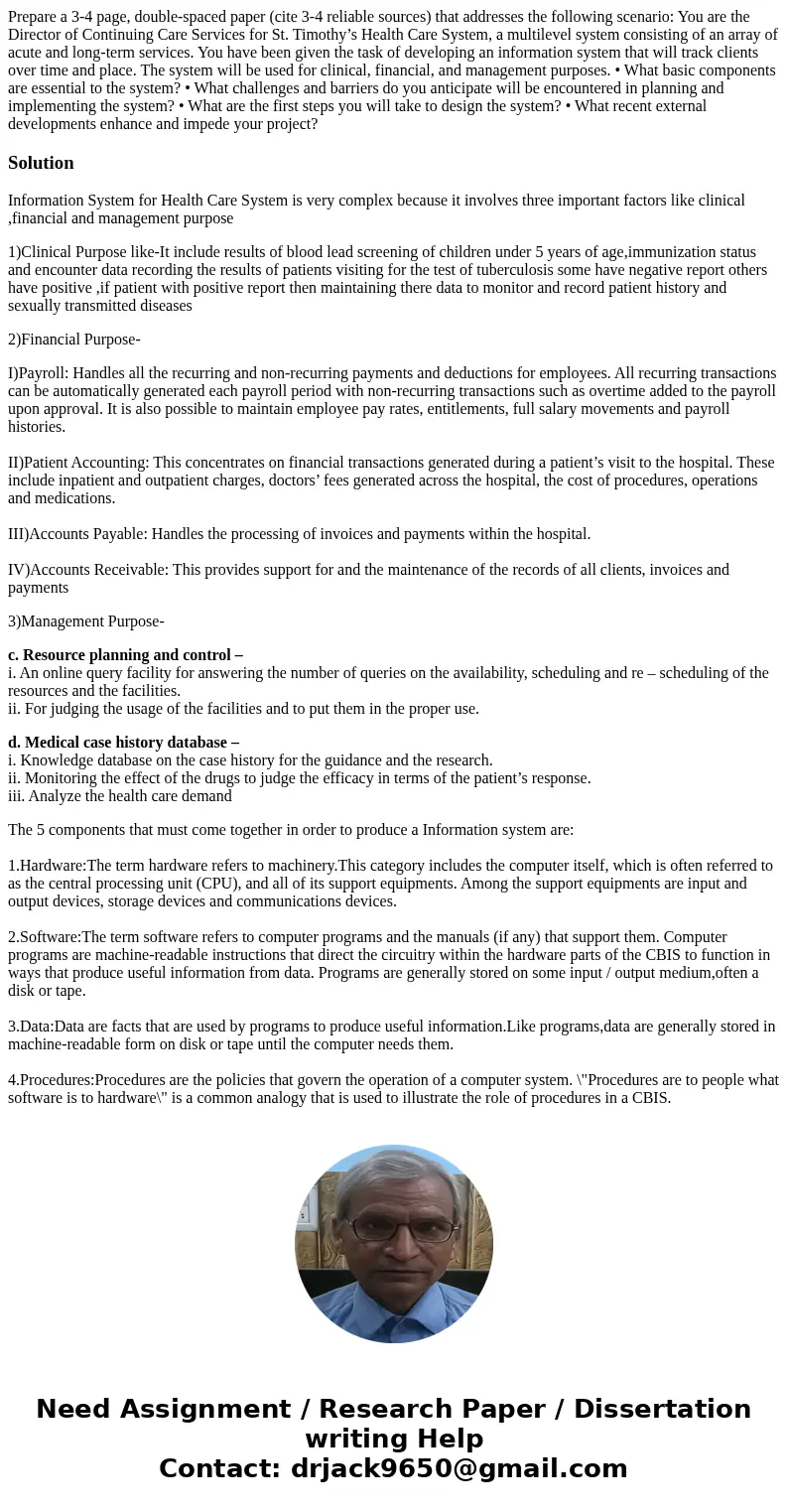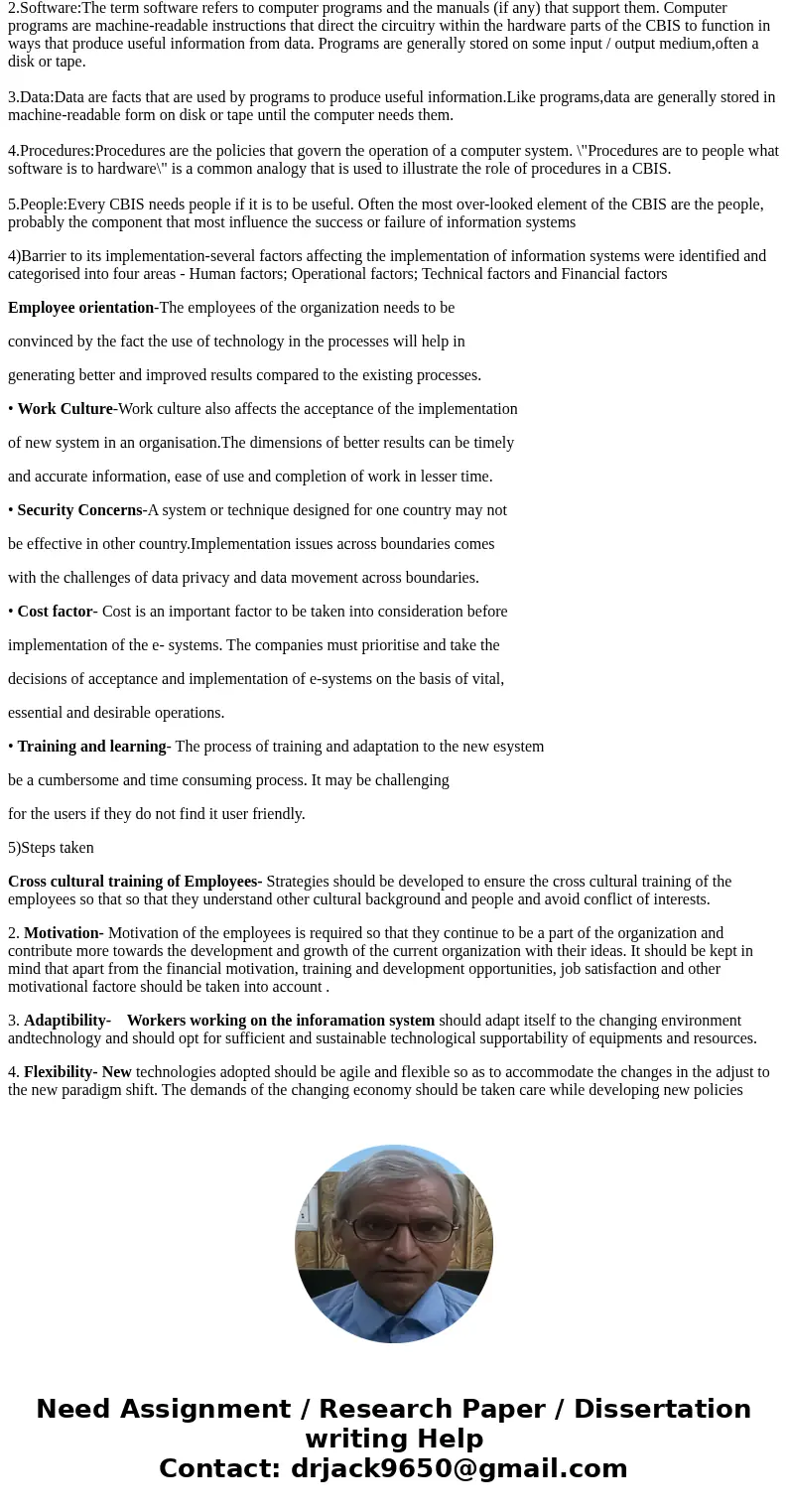Prepare a 34 page doublespaced paper cite 34 reliable source
Prepare a 3-4 page, double-spaced paper (cite 3-4 reliable sources) that addresses the following scenario: You are the Director of Continuing Care Services for St. Timothy’s Health Care System, a multilevel system consisting of an array of acute and long-term services. You have been given the task of developing an information system that will track clients over time and place. The system will be used for clinical, financial, and management purposes. • What basic components are essential to the system? • What challenges and barriers do you anticipate will be encountered in planning and implementing the system? • What are the first steps you will take to design the system? • What recent external developments enhance and impede your project?
Solution
Information System for Health Care System is very complex because it involves three important factors like clinical ,financial and management purpose
1)Clinical Purpose like-It include results of blood lead screening of children under 5 years of age,immunization status and encounter data recording the results of patients visiting for the test of tuberculosis some have negative report others have positive ,if patient with positive report then maintaining there data to monitor and record patient history and sexually transmitted diseases
2)Financial Purpose-
I)Payroll: Handles all the recurring and non-recurring payments and deductions for employees. All recurring transactions can be automatically generated each payroll period with non-recurring transactions such as overtime added to the payroll upon approval. It is also possible to maintain employee pay rates, entitlements, full salary movements and payroll histories.
II)Patient Accounting: This concentrates on financial transactions generated during a patient’s visit to the hospital. These include inpatient and outpatient charges, doctors’ fees generated across the hospital, the cost of procedures, operations and medications.
III)Accounts Payable: Handles the processing of invoices and payments within the hospital.
IV)Accounts Receivable: This provides support for and the maintenance of the records of all clients, invoices and payments
3)Management Purpose-
c. Resource planning and control –
i. An online query facility for answering the number of queries on the availability, scheduling and re – scheduling of the resources and the facilities.
ii. For judging the usage of the facilities and to put them in the proper use.
d. Medical case history database –
i. Knowledge database on the case history for the guidance and the research.
ii. Monitoring the effect of the drugs to judge the efficacy in terms of the patient’s response.
iii. Analyze the health care demand
The 5 components that must come together in order to produce a Information system are:
1.Hardware:The term hardware refers to machinery.This category includes the computer itself, which is often referred to as the central processing unit (CPU), and all of its support equipments. Among the support equipments are input and output devices, storage devices and communications devices.
2.Software:The term software refers to computer programs and the manuals (if any) that support them. Computer programs are machine-readable instructions that direct the circuitry within the hardware parts of the CBIS to function in ways that produce useful information from data. Programs are generally stored on some input / output medium,often a disk or tape.
3.Data:Data are facts that are used by programs to produce useful information.Like programs,data are generally stored in machine-readable form on disk or tape until the computer needs them.
4.Procedures:Procedures are the policies that govern the operation of a computer system. \"Procedures are to people what software is to hardware\" is a common analogy that is used to illustrate the role of procedures in a CBIS.
5.People:Every CBIS needs people if it is to be useful. Often the most over-looked element of the CBIS are the people, probably the component that most influence the success or failure of information systems
4)Barrier to its implementation-several factors affecting the implementation of information systems were identified and categorised into four areas - Human factors; Operational factors; Technical factors and Financial factors
Employee orientation-The employees of the organization needs to be
convinced by the fact the use of technology in the processes will help in
generating better and improved results compared to the existing processes.
• Work Culture-Work culture also affects the acceptance of the implementation
of new system in an organisation.The dimensions of better results can be timely
and accurate information, ease of use and completion of work in lesser time.
• Security Concerns-A system or technique designed for one country may not
be effective in other country.Implementation issues across boundaries comes
with the challenges of data privacy and data movement across boundaries.
• Cost factor- Cost is an important factor to be taken into consideration before
implementation of the e- systems. The companies must prioritise and take the
decisions of acceptance and implementation of e-systems on the basis of vital,
essential and desirable operations.
• Training and learning- The process of training and adaptation to the new esystem
be a cumbersome and time consuming process. It may be challenging
for the users if they do not find it user friendly.
5)Steps taken
Cross cultural training of Employees- Strategies should be developed to ensure the cross cultural training of the employees so that so that they understand other cultural background and people and avoid conflict of interests.
2. Motivation- Motivation of the employees is required so that they continue to be a part of the organization and contribute more towards the development and growth of the current organization with their ideas. It should be kept in mind that apart from the financial motivation, training and development opportunities, job satisfaction and other motivational factore should be taken into account .
3. Adaptibility- Workers working on the inforamation system should adapt itself to the changing environment andtechnology and should opt for sufficient and sustainable technological supportability of equipments and resources.
4. Flexibility- New technologies adopted should be agile and flexible so as to accommodate the changes in the adjust to the new paradigm shift. The demands of the changing economy should be taken care while developing new policies


 Homework Sourse
Homework Sourse